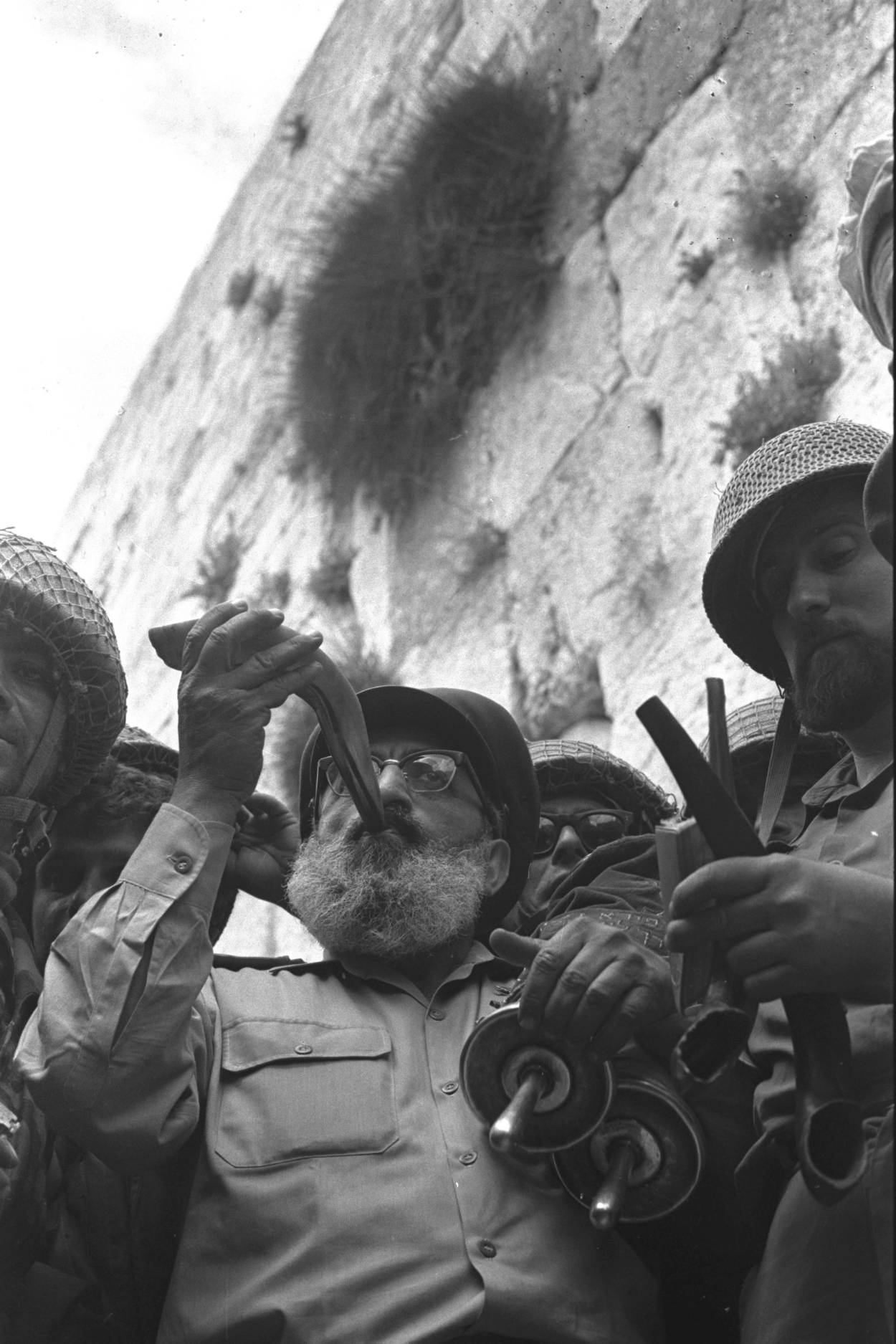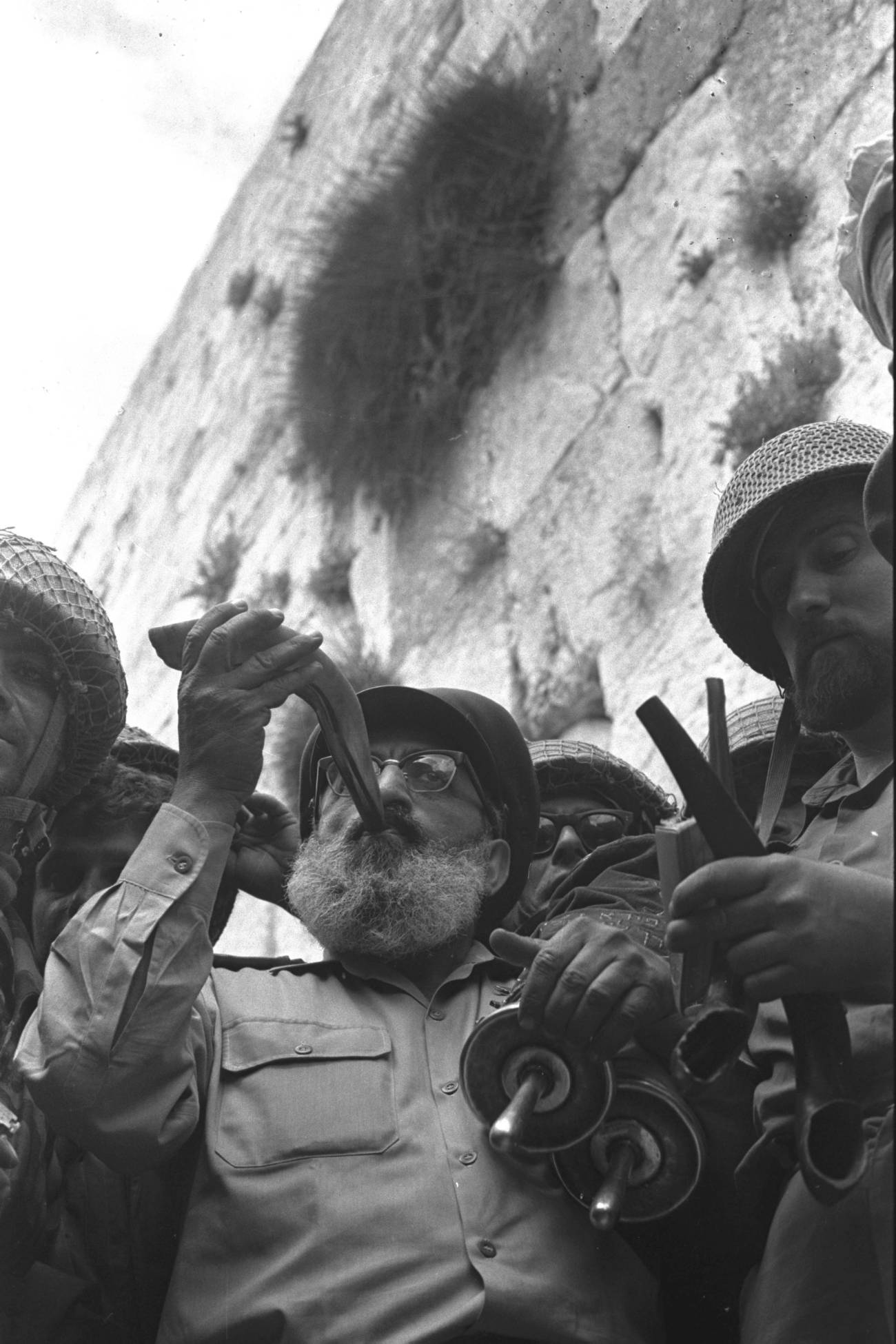The Shofar of Dreams
How a rabbi made history on Mount Sinai

Israeli Government Press Office

Israeli Government Press Office

Israeli Government Press Office

Israeli Government Press Office
While we usually associate the blowing of the shofar with the High Holidays, sometimes it’s more about where it’s blown than when. So it was in 1956 that Rabbi Shlomo Goren received a knock at his door from a man from Tel Aviv who had recently returned from abroad and held an object wrapped in rags. The man, a shofar maker, had received instructions in a dream. “Go to Turkey,” his dream instructed him. “And buy a large ram’s horn. Make it into a shofar for Rabbi Goren to blow on Mount Sinai.”
Goren was born Shlomo Goronchick in Zambrov, Poland. His parents, Hasidim, had sold their belongings and moved to Israel. Their relatives, who stayed in Europe, were murdered by the Nazis. Upon becoming chief rabbi of the Israeli Defense Forces, Goronchick had been encouraged by David Ben-Gurion to Hebraicize his name. “Take off the ‘chick’ and be ‘Goren,’” the prime minister advised. A last name meaning “threshing floor,” the hard surface on which grain was separated from useless straw during biblical times, turned out to be fitting for a man with unyielding determination and a sense of purpose resembling that of the ancient prophets.
Unwrapping the rags, the shofar maker presented Goren with this Turkish shofar, meant to be blown where Moses received the two tablets.
At that point in time, not even the chief rabbi of the IDF presumed that Israel would take over the Sinai Desert, and the Saint Catherine area containing Jebel Musa, known as “the Mountain of Moses.”
“You must be mistaken,” Rabbi Goren insisted. “Perhaps you misunderstood your dream and the shofar is for blowing on the Temple Mount or at the Kotel.” (Rabbi Goren was confident that the Old City of Jerusalem, home of the Temple Mount and the Kotel, then under Jordanian control, would one day be under Israeli sovereignty.)
The man insisted there had been no misunderstanding.
Six months later, the IDF captured the Sinai Desert.
Before the Sinai was returned to Egypt in negotiations, Rabbi Goren climbed 3,300 steps to fulfill the man’s dream. Ignoring an IDF Personnel Department order not to scale the mountain, he had driven through the night, rested at a local monastery, and before dawn began to ascend, accompanied by three other men.
Writing in his memoir, Rabbi Goren recounts:
I felt a deep and overwhelming sense of history. This was the second time in history that a shofar had been blown on Mt. Sinai. The first time, it was Moses who blew it—“and the voice of the shofar sounded louder and louder; Moses speaks and God answers him by a voice” (Exodus 19:19). Now, after thousands of years, I had merited going up Mt. Sinai and blowing the shofar.
Eleven years later, Rabbi Goren found himself on the cusp of liberating Judaism’s holiest site. Though his responsibilities lay more in the realm of faith than of fighting, Rabbi Goren had headed directly into battle.
“I have to cross the lines with the first company that goes across,” he told the 11th Brigade commander, as Goren recounts in his autobiography. The commander hesitated, responding that he needed clearance from the chief of staff to allow the rabbi to take on the enemy gunmen.
“You don’t need any confirmation,” Goren replied. “I’m going on the first troop carrier that crosses the lines.” So Goren went. Like a shepherd heading into battle with a sling and a prayer against a sword-wielding giant, Goren grabbed a Torah scroll and a shofar.
At 4 p.m., his carrier suffered a direct hit. His shofar was burned. Everyone else besides Goren was injured, including the driver, who had shrapnel lodged in his neck. Goren swiftly took a handkerchief out of his pocket, wrapped it around the wound, and dragged the driver out of harm’s way. An ambulance came to take the wounded to the hospital. Goren stayed in the field. He borrowed a helmet from a wounded combat engineer. In his haste heading to the front, Goren had neglected to take protective gear with him, and his hat had been burned by the shell, along with the shofar.
As he recounted later:
I was no longer in the carrier and was alone in the field with the sefer Torah. One side of the field was a swath of ripe grain and the other side was a field of thorns. The Egyptians fired at us incessantly and fires broke out in the field. I was afraid for the sefer Torah and for my life. I dug a deep impression in the ground so that I could protect my head and a deeper impression under my chest, so that I could hold onto the sefer Torah and lean on it. I was sure I would not get out of there alive, and I thought that if I reached the next world, I would be coming with a sefer Torah in my arms.
Somehow, Goren survived an onslaught of heavy fire overhead, and when the sun set, he made his way back to the IDF camp. The driver, who had survived, couldn’t believe Goren had somehow made it out alive.
Goren then realized he needed a new hat. Paying 10 liras for an officer’s cap at command headquarters, he anxiously awaited the next opportunity to head back into battle. When brigade commander Motta Gur was given the order to take the Old City, Goren sprinted straight toward the Lions’ Gate. Paratroopers were spread out along both sides of the road, with heavy artillery raining down incessantly. At the gate, a bus was on fire, and a tank had stalled.
“Rabbi Goren, you’ll get yourself killed,” a battalion commander shouted. “Come with us and stick close to the wall.”
“I’m the highest-ranking officer here,” the chief rabbi, also a lieutenant colonel, replied. “You can’t make me do anything.”
This was the second time in history that a shofar had been blown on Mount Sinai.
Feeling like he was “flying,” Goren headed to the Old City home of his father-in-law, Rabbi David Cohen, a saintly figure known as the Nazir due to his asceticism and piety. Cohen had a small synagogue attached to his apartment. It was 4:30 in the morning.
“I need your shofar,” Goren told his startled father-in-law. “We are going to liberate the Kotel!”
Goren had in mind the biblical practice of blowing a horn in battle. In the book of Numbers, God instructs the Israelites: “and if you go to war in your land, against the enemy that oppresses you, then you shall blow an alarm with the trumpets; and you shall be remembered before the Lord your God and you shall be saved from your enemies.”
Drawing closer to the Lions’ Gate, Goren began blowing the shofar. The Israeli troops reached the tank that had been stuck, blocking the entrance to the Temple Mount. So Goren climbed it and slid down the other side. Making his way to the site of the Temple, in between blasting the shofar, he prayed-shouted to the soldiers, “In the name of God, take action and succeed. In the name of God, liberate Jerusalem, go up and be successful.”
The Old City was recaptured by the IDF. Jerusalem was reunified.
When the dust had settled, Goren headed from the Temple Mount down to the Kotel. A minyan was gathered. There the rabbi recited Kaddish for the soldiers who had fallen in battle. Someone made an audio recording. Paratroopers can be heard crying as the prayer ends. Goren then blew the shofar.
After having nearly ascended to heaven with a Torah scroll in his arms, Goren returned to Mount Sinai. He began writing a sefer Torah there. Completed two years later at the same spot, the Torah now sits in the ark in the Komemiut Avraham synagogue in Tel Aviv.
In a halachic essay examining the nature of Rosh Hashanah, Rabbi Goren mentions a millennia-old debate regarding the nature of the holiday, in which the shofar blasts are the central ritual. Perhaps, as some rabbis have suggested, one’s emotional register on the holiday should be crying, even mourning. After all, as Rabbi Alan Lew’s now-classic reflection on the High Holidays put it, picturing ourselves being inscribed in the Book of Life—or the alternative—makes the prospect of death real. And for this, we are often completely unprepared. We might not luck out when we forget to wear a helmet. As Lew puts it, there “are the times when the solid ground we thought we stood on disappears beneath our feet, leaving us reeling and heartbroken.” The siren call of the shofar becomes the wailing Kaddish for the fallen.
The second rabbinic perspective is the exact opposite. Rosh Hashanah, seen from this angle, is a celebratory renewal, meant to be accompanied by festive food and drink. A clarion call to covenant, the shofar harks back to Sinai’s revelation, immortally inscribed in the sefer Torah. The Torah, as an ancient rabbinic teaching has it, was God’s blueprint for the world. And the world’s birthday is Rosh Hashanah. We are meant to rejoice in the shofar’s celebratory sound.
Perhaps somewhere in the ditch, clutching the scroll with bullets overhead, or between ankle-aching steps up the mountain where Moses once moved, Rabbi Goren pondered this debate. Likely, had an authority figure, be it military or rabbinic, offered an attempt to settle the matter, Rabbi Goren would have plowed ahead with his own opposing view. But maybe that’s the point. Both heartbreaking and heavenly, symbolizing sacrifice and spiritual success, the shofar’s sound calls, ever still.
Rabbi Dr. Stuart Halpern is Senior Adviser to the Provost of Yeshiva University and Deputy Director of Y.U.’s Straus Center for Torah and Western Thought. His books include The Promise of Liberty: A Passover Haggada, which examines the Exodus story’s impact on the United States, Esther in America, Gleanings: Reflections on Ruth and Proclaim Liberty Throughout the Land: The Hebrew Bible in the United States.